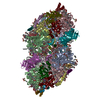+ Open data
Open data
- Basic information
Basic information
| Entry | Database: PDB / ID: 7d1t | |||||||||||||||||||||||||||||||||||||||||||||
|---|---|---|---|---|---|---|---|---|---|---|---|---|---|---|---|---|---|---|---|---|---|---|---|---|---|---|---|---|---|---|---|---|---|---|---|---|---|---|---|---|---|---|---|---|---|---|
| Title | Cryo-EM Structure of PSII at 1.95 angstrom resolution | |||||||||||||||||||||||||||||||||||||||||||||
 Components Components |
| |||||||||||||||||||||||||||||||||||||||||||||
 Keywords Keywords | PHOTOSYNTHESIS / Photosystem II | |||||||||||||||||||||||||||||||||||||||||||||
| Function / homology |  Function and homology information Function and homology informationphotosystem II oxygen evolving complex / photosystem II assembly / oxygen evolving activity / photosystem II stabilization / photosystem II reaction center / photosystem II / oxidoreductase activity, acting on diphenols and related substances as donors, oxygen as acceptor / photosynthetic electron transport chain / photosystem II / response to herbicide ...photosystem II oxygen evolving complex / photosystem II assembly / oxygen evolving activity / photosystem II stabilization / photosystem II reaction center / photosystem II / oxidoreductase activity, acting on diphenols and related substances as donors, oxygen as acceptor / photosynthetic electron transport chain / photosystem II / response to herbicide / extrinsic component of membrane / chlorophyll binding / plasma membrane-derived thylakoid membrane / photosynthetic electron transport in photosystem II / : / phosphate ion binding / photosynthesis, light reaction / photosynthesis / respiratory electron transport chain / manganese ion binding / electron transfer activity / protein stabilization / iron ion binding / heme binding / metal ion binding Similarity search - Function | |||||||||||||||||||||||||||||||||||||||||||||
| Biological species |  Thermosynechococcus vulcanus (bacteria) Thermosynechococcus vulcanus (bacteria) | |||||||||||||||||||||||||||||||||||||||||||||
| Method | ELECTRON MICROSCOPY / single particle reconstruction / cryo EM / Resolution: 1.95 Å | |||||||||||||||||||||||||||||||||||||||||||||
 Authors Authors | Kato, K. / Miyazaki, N. / Hamaguchi, T. / Nakajima, Y. / Akita, F. / Yonekura, K. / Shen, J.R. | |||||||||||||||||||||||||||||||||||||||||||||
 Citation Citation |  Journal: Commun Biol / Year: 2021 Journal: Commun Biol / Year: 2021Title: High-resolution cryo-EM structure of photosystem II reveals damage from high-dose electron beams. Authors: Koji Kato / Naoyuki Miyazaki / Tasuku Hamaguchi / Yoshiki Nakajima / Fusamichi Akita / Koji Yonekura / Jian-Ren Shen /  Abstract: Photosystem II (PSII) plays a key role in water-splitting and oxygen evolution. X-ray crystallography has revealed its atomic structure and some intermediate structures. However, these structures are ...Photosystem II (PSII) plays a key role in water-splitting and oxygen evolution. X-ray crystallography has revealed its atomic structure and some intermediate structures. However, these structures are in the crystalline state and its final state structure has not been solved. Here we analyzed the structure of PSII in solution at 1.95 Å resolution by single-particle cryo-electron microscopy (cryo-EM). The structure obtained is similar to the crystal structure, but a PsbY subunit was visible in the cryo-EM structure, indicating that it represents its physiological state more closely. Electron beam damage was observed at a high-dose in the regions that were easily affected by redox states, and reducing the beam dosage by reducing frames from 50 to 2 yielded a similar resolution but reduced the damage remarkably. This study will serve as a good indicator for determining damage-free cryo-EM structures of not only PSII but also all biological samples, especially redox-active metalloproteins. | |||||||||||||||||||||||||||||||||||||||||||||
| History |
|
- Structure visualization
Structure visualization
| Movie |
 Movie viewer Movie viewer |
|---|---|
| Structure viewer | Molecule:  Molmil Molmil Jmol/JSmol Jmol/JSmol |
- Downloads & links
Downloads & links
- Download
Download
| PDBx/mmCIF format |  7d1t.cif.gz 7d1t.cif.gz | 1.3 MB | Display |  PDBx/mmCIF format PDBx/mmCIF format |
|---|---|---|---|---|
| PDB format |  pdb7d1t.ent.gz pdb7d1t.ent.gz | 1 MB | Display |  PDB format PDB format |
| PDBx/mmJSON format |  7d1t.json.gz 7d1t.json.gz | Tree view |  PDBx/mmJSON format PDBx/mmJSON format | |
| Others |  Other downloads Other downloads |
-Validation report
| Summary document |  7d1t_validation.pdf.gz 7d1t_validation.pdf.gz | 6.7 MB | Display |  wwPDB validaton report wwPDB validaton report |
|---|---|---|---|---|
| Full document |  7d1t_full_validation.pdf.gz 7d1t_full_validation.pdf.gz | 7.1 MB | Display | |
| Data in XML |  7d1t_validation.xml.gz 7d1t_validation.xml.gz | 177.3 KB | Display | |
| Data in CIF |  7d1t_validation.cif.gz 7d1t_validation.cif.gz | 225.1 KB | Display | |
| Arichive directory |  https://data.pdbj.org/pub/pdb/validation_reports/d1/7d1t https://data.pdbj.org/pub/pdb/validation_reports/d1/7d1t ftp://data.pdbj.org/pub/pdb/validation_reports/d1/7d1t ftp://data.pdbj.org/pub/pdb/validation_reports/d1/7d1t | HTTPS FTP |
-Related structure data
| Related structure data |  30547MC  7d1uC M: map data used to model this data C: citing same article ( |
|---|---|
| Similar structure data | |
| EM raw data |  EMPIAR-10556 (Title: Cryo-EM Structure of PSII at 1.95 angstrom resolution EMPIAR-10556 (Title: Cryo-EM Structure of PSII at 1.95 angstrom resolutionData size: 427.6 Data #1: Unaligned multi-frame micrographs of PSII recorded by CRYO ARM 300 [micrographs - multiframe]) |
- Links
Links
- Assembly
Assembly
| Deposited unit | 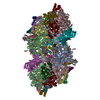
|
|---|---|
| 1 |
|
- Components
Components
-Photosystem II ... , 17 types, 34 molecules AaBbCcDdHhIiJjKkLlMmOoTtUuYyXx...
| #1: Protein | Mass: 37029.234 Da / Num. of mol.: 2 / Source method: isolated from a natural source / Source: (natural)  Thermosynechococcus vulcanus (bacteria) / References: UniProt: P51765, photosystem II Thermosynechococcus vulcanus (bacteria) / References: UniProt: P51765, photosystem II#2: Protein | Mass: 56068.742 Da / Num. of mol.: 2 / Source method: isolated from a natural source / Source: (natural)  Thermosynechococcus vulcanus (bacteria) / References: UniProt: D0VWR1 Thermosynechococcus vulcanus (bacteria) / References: UniProt: D0VWR1#3: Protein | Mass: 49207.250 Da / Num. of mol.: 2 / Source method: isolated from a natural source / Source: (natural)  Thermosynechococcus vulcanus (bacteria) / References: UniProt: D0VWR7 Thermosynechococcus vulcanus (bacteria) / References: UniProt: D0VWR7#4: Protein | Mass: 38419.941 Da / Num. of mol.: 2 / Source method: isolated from a natural source / Source: (natural)  Thermosynechococcus vulcanus (bacteria) / References: UniProt: D0VWR8, photosystem II Thermosynechococcus vulcanus (bacteria) / References: UniProt: D0VWR8, photosystem II#7: Protein | Mass: 7057.349 Da / Num. of mol.: 2 / Source method: isolated from a natural source / Source: (natural)  Thermosynechococcus vulcanus (bacteria) / References: UniProt: P19052 Thermosynechococcus vulcanus (bacteria) / References: UniProt: P19052#8: Protein/peptide | Mass: 4195.983 Da / Num. of mol.: 2 / Source method: isolated from a natural source / Source: (natural)  Thermosynechococcus vulcanus (bacteria) / References: UniProt: P12240 Thermosynechococcus vulcanus (bacteria) / References: UniProt: P12240#9: Protein/peptide | Mass: 3756.439 Da / Num. of mol.: 2 / Source method: isolated from a natural source / Source: (natural)  Thermosynechococcus vulcanus (bacteria) / References: UniProt: Q7DGD4 Thermosynechococcus vulcanus (bacteria) / References: UniProt: Q7DGD4#10: Protein/peptide | Mass: 4101.911 Da / Num. of mol.: 2 / Source method: isolated from a natural source / Source: (natural)  Thermosynechococcus vulcanus (bacteria) / References: UniProt: P19054 Thermosynechococcus vulcanus (bacteria) / References: UniProt: P19054#11: Protein/peptide | Mass: 4299.044 Da / Num. of mol.: 2 / Source method: isolated from a natural source / Source: (natural)  Thermosynechococcus vulcanus (bacteria) / References: UniProt: P12241 Thermosynechococcus vulcanus (bacteria) / References: UniProt: P12241#12: Protein/peptide | Mass: 3835.527 Da / Num. of mol.: 2 / Source method: isolated from a natural source / Source: (natural)  Thermosynechococcus vulcanus (bacteria) / References: UniProt: P12312 Thermosynechococcus vulcanus (bacteria) / References: UniProt: P12312#13: Protein | Mass: 26651.707 Da / Num. of mol.: 2 / Source method: isolated from a natural source / Source: (natural)  Thermosynechococcus vulcanus (bacteria) / References: UniProt: D0VWR2 Thermosynechococcus vulcanus (bacteria) / References: UniProt: D0VWR2#14: Protein/peptide | Mass: 3777.559 Da / Num. of mol.: 2 / Source method: isolated from a natural source / Source: (natural)  Thermosynechococcus vulcanus (bacteria) / References: UniProt: P12313 Thermosynechococcus vulcanus (bacteria) / References: UniProt: P12313#15: Protein | Mass: 10966.317 Da / Num. of mol.: 2 / Source method: isolated from a natural source / Source: (natural)  Thermosynechococcus vulcanus (bacteria) / References: UniProt: P56152 Thermosynechococcus vulcanus (bacteria) / References: UniProt: P56152#17: Protein/peptide | Mass: 3228.035 Da / Num. of mol.: 2 / Source method: isolated from a natural source / Source: (natural)  Thermosynechococcus vulcanus (bacteria) / References: UniProt: D0VWR3 Thermosynechococcus vulcanus (bacteria) / References: UniProt: D0VWR3#18: Protein/peptide | Mass: 4191.030 Da / Num. of mol.: 2 / Source method: isolated from a natural source / Source: (natural)  Thermosynechococcus vulcanus (bacteria) / References: UniProt: D0VWR4 Thermosynechococcus vulcanus (bacteria) / References: UniProt: D0VWR4#19: Protein | Mass: 6766.187 Da / Num. of mol.: 2 / Source method: isolated from a natural source / Source: (natural)  Thermosynechococcus vulcanus (bacteria) / References: UniProt: D0VWR5 Thermosynechococcus vulcanus (bacteria) / References: UniProt: D0VWR5#20: Protein/peptide | Mass: 3859.732 Da / Num. of mol.: 2 / Source method: isolated from a natural source / Source: (natural)  Thermosynechococcus vulcanus (bacteria) / References: UniProt: P0DM37 Thermosynechococcus vulcanus (bacteria) / References: UniProt: P0DM37 |
|---|
-Cytochrome b559 subunit ... , 2 types, 4 molecules EeFf
| #5: Protein | Mass: 9321.515 Da / Num. of mol.: 2 / Source method: isolated from a natural source / Source: (natural)  Thermosynechococcus vulcanus (bacteria) / References: UniProt: P12238 Thermosynechococcus vulcanus (bacteria) / References: UniProt: P12238#6: Protein/peptide | Mass: 3868.611 Da / Num. of mol.: 2 / Source method: isolated from a natural source / Source: (natural)  Thermosynechococcus vulcanus (bacteria) / References: UniProt: P12239 Thermosynechococcus vulcanus (bacteria) / References: UniProt: P12239 |
|---|
-Protein , 1 types, 2 molecules Vv
| #16: Protein | Mass: 15148.255 Da / Num. of mol.: 2 / Source method: isolated from a natural source / Source: (natural)  Thermosynechococcus vulcanus (bacteria) / References: UniProt: P0A387 Thermosynechococcus vulcanus (bacteria) / References: UniProt: P0A387 |
|---|
-Sugars , 2 types, 16 molecules 
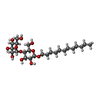

| #31: Sugar | ChemComp-DGD / #32: Sugar | ChemComp-LMT / |
|---|
-Non-polymers , 17 types, 2612 molecules 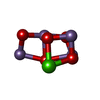






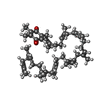

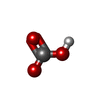



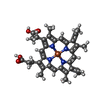

















| #21: Chemical | | #22: Chemical | #23: Chemical | ChemComp-CL / #24: Chemical | ChemComp-CLA / #25: Chemical | ChemComp-PHO / #26: Chemical | ChemComp-BCR / #27: Chemical | ChemComp-SQD / #28: Chemical | ChemComp-PL9 / #29: Chemical | ChemComp-UNL / Num. of mol.: 36 / Source method: obtained synthetically #30: Chemical | ChemComp-LMG / #33: Chemical | #34: Chemical | ChemComp-LHG / #35: Chemical | #36: Chemical | #37: Chemical | #38: Chemical | #39: Water | ChemComp-HOH / | |
|---|
-Details
| Has ligand of interest | N |
|---|---|
| Has protein modification | Y |
-Experimental details
-Experiment
| Experiment | Method: ELECTRON MICROSCOPY |
|---|---|
| EM experiment | Aggregation state: PARTICLE / 3D reconstruction method: single particle reconstruction |
- Sample preparation
Sample preparation
| Component | Name: PSII dimer / Type: COMPLEX / Entity ID: #1-#20 / Source: NATURAL | ||||||||||||
|---|---|---|---|---|---|---|---|---|---|---|---|---|---|
| Molecular weight | Value: 0.725 MDa / Experimental value: NO | ||||||||||||
| Source (natural) | Organism:  Thermosynechococcus vulcanus (bacteria) Thermosynechococcus vulcanus (bacteria) | ||||||||||||
| Buffer solution | pH: 6 | ||||||||||||
| Buffer component |
| ||||||||||||
| Specimen | Conc.: 2 mg/ml / Embedding applied: NO / Shadowing applied: NO / Staining applied: NO / Vitrification applied: YES | ||||||||||||
| Specimen support | Grid material: COPPER / Grid mesh size: 200 divisions/in. / Grid type: Quantifoil R1.2/1.3 | ||||||||||||
| Vitrification | Instrument: FEI VITROBOT MARK IV / Cryogen name: ETHANE / Humidity: 100 % / Chamber temperature: 277 K |
- Electron microscopy imaging
Electron microscopy imaging
| Microscopy | Model: JEOL CRYO ARM 300 |
|---|---|
| Electron gun | Electron source:  FIELD EMISSION GUN / Accelerating voltage: 300 kV / Illumination mode: FLOOD BEAM FIELD EMISSION GUN / Accelerating voltage: 300 kV / Illumination mode: FLOOD BEAM |
| Electron lens | Mode: BRIGHT FIELD |
| Image recording | Electron dose: 83 e/Å2 / Detector mode: COUNTING / Film or detector model: GATAN K2 SUMMIT (4k x 4k) |
- Processing
Processing
| Software | Name: PHENIX / Version: 1.14_3260: / Classification: refinement | ||||||||||||||||||||
|---|---|---|---|---|---|---|---|---|---|---|---|---|---|---|---|---|---|---|---|---|---|
| EM software |
| ||||||||||||||||||||
| CTF correction | Type: PHASE FLIPPING AND AMPLITUDE CORRECTION | ||||||||||||||||||||
| Symmetry | Point symmetry: C2 (2 fold cyclic) | ||||||||||||||||||||
| 3D reconstruction | Resolution: 1.95 Å / Resolution method: FSC 0.143 CUT-OFF / Num. of particles: 174099 / Algorithm: FOURIER SPACE / Symmetry type: POINT | ||||||||||||||||||||
| Atomic model building | Protocol: FLEXIBLE FIT / Space: REAL | ||||||||||||||||||||
| Atomic model building | PDB-ID: 3WU2 Accession code: 3WU2 / Source name: PDB / Type: experimental model |
 Movie
Movie Controller
Controller






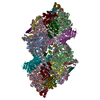

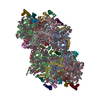
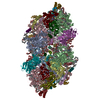



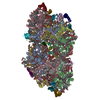


 PDBj
PDBj































